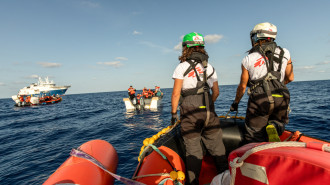The year of the Muslim model
The year of the Muslim model
From television screens to magazine covers and billboards, hijab-clad women are breaking through and are being featured by mainstream brands.
3 min read
2017 was the year of the Muslim model [Getty/Instagram/Facebook]
In a bid to be more inclusive and cater to a larger demographic - with a combined spending power of £20.5 billion - it seems fashion and beauty brands are targeting Muslim women, and what better way to do so then to use hijabis in their campaigns?
2017 was undoubtedly the year of the Muslim model. From television screens, to magazine covers and billboards, hijab-clad women have been featured heavily by mainstream brands in order to sell products and represent a somewhat marginalised and misunderstood group.
Many have applauded this move, especially in the current political climate, where Muslims are under more scrutiny than ever before.
The past year has seen a flourishing of hijab-wearing women appearing in adverts, magazines and on TV. The biggest success story comes from refugee-turned-supermodel Halima Aden who was the first hijabi woman to grace the covers of Allure and Vogue magazine. She also went on to appear in Kanye West's "Yeezy" show at New York Fashion Week and modelled for Rihanna's cosmetic line, Fenty Beauty.
Then there's hijabi blogger Ruba Zai, 23, who in 2017 was named the new face of Dolce & Gabbana.
2017 was undoubtedly the year of the Muslim model. From television screens, to magazine covers and billboards, hijab-clad women have been featured heavily by mainstream brands in order to sell products and represent a somewhat marginalised and misunderstood group.
Many have applauded this move, especially in the current political climate, where Muslims are under more scrutiny than ever before.
The past year has seen a flourishing of hijab-wearing women appearing in adverts, magazines and on TV. The biggest success story comes from refugee-turned-supermodel Halima Aden who was the first hijabi woman to grace the covers of Allure and Vogue magazine. She also went on to appear in Kanye West's "Yeezy" show at New York Fashion Week and modelled for Rihanna's cosmetic line, Fenty Beauty.
 |
|
| Halima Aden poses during Glamour Celebrates 2017 Women Of The Year Live Summit in New York City [Getty] |
Then there's hijabi blogger Ruba Zai, 23, who in 2017 was named the new face of Dolce & Gabbana.
| Instagram Post |
YouTuber Amena Khan was revealed as a L'Oreal model, fashion designer Dina Torkia featured in the latest Colgate advert and CoverGirl named makeup artist Nura Afia as their newest beauty ambassador.
This sudden surge of Muslim women in mainstream media has had mixed reactions. Many have applauded the bold move as it gives them a much-needed platform. It educates the naysayers and ignorant who believe Islam oppresses women. As well as normalising the hijab, these brands are giving Muslim women a voice.
However, before we start cheering on the trailblazers, it's worth remembering that modesty and modelling don't necessarily always go hand-in-hand.
When journalist Noor Tagouri appeared in the pages of Playboy magazine it sparked controversy and shock in many Muslim communities.
Although the publication stopped publishing nude photoshoots many years back, the brand is still recognised for its sexualisation of women - a value that is in clear odds with Islam and the hijab.
| Instagram Post |
Maybe 2018 could be the year that the hijab goes mainstream but, among the fabulous fashion and glamorous makeup, it may be in danger of losing its identity.
![Muslim models [Getty/Instagram/Facebook] Muslim models [Getty/Instagram/Facebook]](/sites/default/files/styles/image_345x195/public/media/images/3F643E96-50C4-4169-9132-7CFD8673D8D7.jpg?h=d1cb525d&itok=cCWtY-0x)




 Follow the Middle East's top stories in English at The New Arab on Google News
Follow the Middle East's top stories in English at The New Arab on Google News


